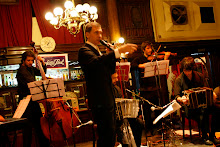martes, 1 de septiembre de 2009
EL TANGO ARGENTINO ./ ARGENTINE TANGO
Originariamente, el tango nace a fines del siglo XIX de una mezcla de varios ritmos provenientes de los suburbios de Buenos Aires y de otras musicas de origen africano y cubano. Estuvo asociado desde un principio con burdeles y cabarets, ámbito de contención de una población inmigrante netamente masculina. Debido a que solo las prostitutas aceptarían dicho baile, en sus comienzos era común que el tango se bailara por una pareja de hombres.
Pero el tango como danza no se limitó a las zonas bajas o a sus ambientes cercanos. Se extendió también a los barrios proletarios y empezó a ganar aceptación "en las mejores familias", sobretodo después que el baile tuvo éxito en Europa.
La melodía provenía de flauta, violín y guitarra. Posteriormente, la flauta fue reemplazada por el "bandoneón". Los inmigrantes contribuyeron añadiendo aires de nostalgia a las canciones y de ese modo el tango se fue desarrollando y adquiriendo un sabor único.
Carlos Gardel fue el mas grande intérprete y creador del tango-canción. Fallecido en 1935 a los 45 años en un accidente aéreo en Medellín Colombia, fue el gran divulgador del tango en el extranjero. En los 60, en cambio, el genero fue ignorado fuera de la Argentina.
Resurgió renovado por Astor Piazzolla, quien le dió una nueva perspectiva, rompiendo con los esquemas del tango clásico.
Hoy el tango está más vivo que nunca, no como el fenómeno de masas que lo engendró, sino como incuestionable elemento identificatorio del alma porteña y en permanentes evocaciones desparramadas por todo Buenos Aires y el mundo entero.
ENGLISH VERSION
The tango was born by the end of the 19th century from a mixture of several rhythms that were danced in the suburbs of Buenos Aires. Originally it was almost exclusively connected to cabarets, a sort of contention house for the predominantly male population that was increasingly immigrating to the country. Since only prostitutes would dare performing this dance, in the beginning most couples were formed by two men.
The tango then started to call more and more attention, not only in the obscure areas where it came from but also among working-class neighborhoods. Even respected Argentine families got fascinatated by the dance, especially after it reached great success in Paris and then all over Europe.
Its distinctive sound came to life thanks to the combination of violin, guitar and flute, which was eventually replaced by the "bandoneón" or concertina. Additionally, the immigrants added all their nostalgia to the lyrics and helped to develop tango's unique flavor.
Carlos Gardel was the first and most famous tango singer, who also gave an enormous contribution to spreading this Argentine music overseas until he tragically died in 1935 in Medellín Colombia.
During the 60's, the tango had been virtually abandoned outside its home country, but it was brought to life again thanks to the more jazzistic traits added by bandoneón genius Astor Piazzolla.
Nowadays, the tango is more alive then ever. Although it is not a massive phenomenon as in its early years, it is still the best way to penetrate the Buenos Aires soul and will always stand as its most genuine symbol.
Pero el tango como danza no se limitó a las zonas bajas o a sus ambientes cercanos. Se extendió también a los barrios proletarios y empezó a ganar aceptación "en las mejores familias", sobretodo después que el baile tuvo éxito en Europa.
La melodía provenía de flauta, violín y guitarra. Posteriormente, la flauta fue reemplazada por el "bandoneón". Los inmigrantes contribuyeron añadiendo aires de nostalgia a las canciones y de ese modo el tango se fue desarrollando y adquiriendo un sabor único.
Carlos Gardel fue el mas grande intérprete y creador del tango-canción. Fallecido en 1935 a los 45 años en un accidente aéreo en Medellín Colombia, fue el gran divulgador del tango en el extranjero. En los 60, en cambio, el genero fue ignorado fuera de la Argentina.
Resurgió renovado por Astor Piazzolla, quien le dió una nueva perspectiva, rompiendo con los esquemas del tango clásico.
Hoy el tango está más vivo que nunca, no como el fenómeno de masas que lo engendró, sino como incuestionable elemento identificatorio del alma porteña y en permanentes evocaciones desparramadas por todo Buenos Aires y el mundo entero.
ENGLISH VERSION
The tango was born by the end of the 19th century from a mixture of several rhythms that were danced in the suburbs of Buenos Aires. Originally it was almost exclusively connected to cabarets, a sort of contention house for the predominantly male population that was increasingly immigrating to the country. Since only prostitutes would dare performing this dance, in the beginning most couples were formed by two men.
The tango then started to call more and more attention, not only in the obscure areas where it came from but also among working-class neighborhoods. Even respected Argentine families got fascinatated by the dance, especially after it reached great success in Paris and then all over Europe.
Its distinctive sound came to life thanks to the combination of violin, guitar and flute, which was eventually replaced by the "bandoneón" or concertina. Additionally, the immigrants added all their nostalgia to the lyrics and helped to develop tango's unique flavor.
Carlos Gardel was the first and most famous tango singer, who also gave an enormous contribution to spreading this Argentine music overseas until he tragically died in 1935 in Medellín Colombia.
During the 60's, the tango had been virtually abandoned outside its home country, but it was brought to life again thanks to the more jazzistic traits added by bandoneón genius Astor Piazzolla.
Nowadays, the tango is more alive then ever. Although it is not a massive phenomenon as in its early years, it is still the best way to penetrate the Buenos Aires soul and will always stand as its most genuine symbol.
Etiquetas:
TANGO ARGENTINO / ARGENTINE TANGO DANCE


